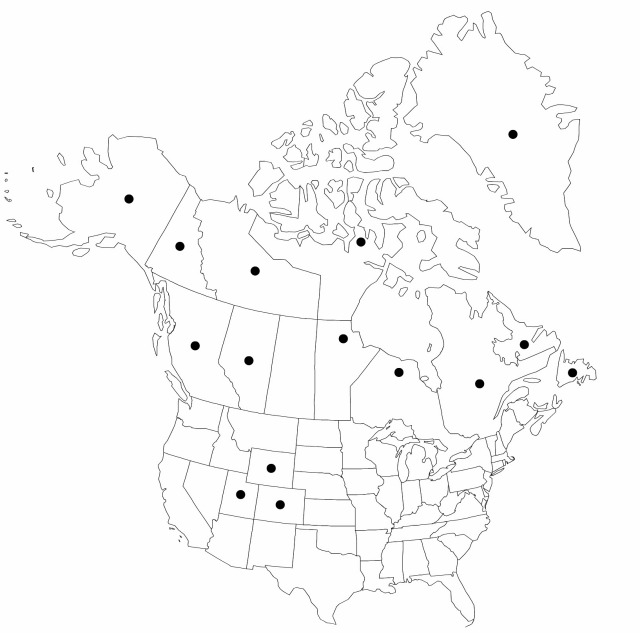Carex microglochin subsp. microglochin
Rhizomes 0.2–4(–6) cm × 0.5–1 mm. Culms arising singly or 2–4 together, (2–)4–23(–36) cm, glabrous. Leaves: the proximal blade-bearing; foliage leaves 4–10 per culm; ligules much wider than long; blades 1–8(–14) cm × 0.5–0.8 mm. Spike with 4–8 staminate flowers and 3–10 pistillate flowers, 6–14 × 2–9 (immature fruit) or 4–11 (mature fruit) mm. Pistillate scales (except the proximal) 2.4–3 mm, wider than and 1/2 length of perigynia. Staminate scales appressed. Perigynia pale green to straw colored, lance-subulate, 3.4–4.7 × 0.5–0.7 mm; beak scarcely differentiated; rachilla bristlelike, exserted 0.5–2.8 mm beyond orifice of beak. Achenes 2.1–2.4 × 0.5–0.7 mm; style not exserted. 2n = 50.
Phenology: Fruiting summer (mid Jun–late Aug).
Habitat: Moist, calcareous, often peaty ground in open barrens, tundra (often very wet or flooded), fens, seeps over shallow bedrock, and boggy subalpine meadows, also sandy or gravelly river flats and clay or silt at lakeshores and seasides
Elevation: 0–3700 m
Distribution

Greenland, Alta., B.C., Man., Nfld. and Labr., N.W.T., Nunavut, Ont., Que., Yukon, Alaska, Colo., Utah, Wyo., Eurasia.
Discussion
Carex microglochin subsp. microglochin is usually rare to occasional in subarctic North America and scattered in the cordilleran region. It can be locally abundant (e.g., Brooks Range, Alaska) or even dominant (e.g., western Newfoundland) despite its very spotty geographic range. It was reported from Montana by W. E. Booth (1950) and F. J. Hermann (1970); no verifying specimens have been found. Many authors, including cyperologists (e.g., E. R. Guaglianone 1996), have agreed that the populations found in Argentina, Chile, and the Falkland Islands constitute a vicariant here treated as C. microglochin subsp. fuegina Kükenthal [C. oligantha W. Boott, not Steudel; C. microglochin var. oligantha Kükenthal], differing from subsp. microglochin primarily in having fewer flowers per spike and slightly longer perigynia with longer stipes. H. Roivainen (1954) asserted that both taxa (as C. microglochin and C. oligantha) occur in Tierra del Fuego.
Carex microglochin subsp. microglochin is an inconspicuous but interesting little plant, distinctive in having a well-developed rachilla very similar in appearance to the exserted style of C. pauciflora. The long-pointed perigynia, which mature quickly and detach easily, are probably dispersed by animals (M. L. Fernald 1926; D. B. O. Savile 1972).
Selected References
None.